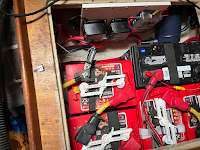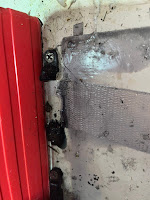I'd really rather forget this incident than share it, but it taught/reminded me of several very important considerations. Retaining self-confidence in a discipline after years of unuse is a dangerous thing, the marine environment is inherently unsafe -- combine the two and you are depending mostly on luck... not a best practice.
Living on a mooring is not easy! I fell asleep early that night, at about 7:30 PM, didn’t make our usual evening trip to shore for my dogs to do their business. I woke up about 3AM to a couple of very agitated dogs, so we hopped into the dingy, headed for shore. The wind was pretty frisky that night.
We’ve been having an ongoing difficulty with the outboard motor’s external (3 gal) fuel tank, which forces us to rely on the internal (1/3 gal) tank — it doesn’t take us very far.
With the external tank full and onboard, we ran out of gas. Nothing about either tank lends itself to transferring fuel between them, best case is you spill gas all over the outboard to get 1/4 gal into it. Worst case, the dingy burns to the waterline and you end up in a burn unit. One spark is all that separates those potential outcomes.
We have performed this awkward, messy, dangerous refueling operation a few times in the daylight, this time it was pitch black. I did have a flashlight but couldn’t hold it, position it or prop it up to make it useful. I wasn’t getting any fuel into the tank, just all over the motor, myself and the dingy.
I couldn’t say how long these attempts to transfer fuel took, clearly way too long. I have a small anchor in the dingy for precisely such occasions but the dogs were on top of it. Never would I have dreamed how big of a mistake it was, to fail to drop that anchor when it would’ve been effective. When I realized we were in trouble the water was too deep.
As I looked around I was in denial, surprised that the pier would be so dark. But the depth of the water and the nearby sound of the whistle buoy brought it home, we were way past the end of the pier, beyond the breakwater, in the open ocean not far from the start of the harbor’s marked channel. The wind had blown us more than 1.5 nautical miles. God damn it! In a tiny little inflatable boat, that’s a very long way!
I did have oars but they are not my friends. I bet we drifted another half a mile fumbling with and cursing at the damn oar locks. Fuck those things!
So human propulsion engaged, time for navigation: I correctly identified the back side of the breakwater, and the work lights of a barge servicing it. At least I knew where I was. Visually and audibly I seemed to be advancing at least a little bit, but the whistle buoy was a two-edged sword, it getting louder could indicate I was going the right way up the coast, but it could also indicate I was being swept farther out to sea.
Aiming for the tip of the breakwater I understood that I had to keep myself between that buoy and the wind, even if I couldn't hold my position by rowing against the weather, tying to the buoy was my last hope, the last guarantee we would be spotted. If swept past that, with no communications, we were just a speck in the vast sea.
During all of this I saw three boats going out, one of them heading straight for us, I could see its red and green nav lights as I flashed SOS at it. I guess I should be grateful it turned to avoid hitting us. It emphasizes the point that out there you are on your own! "Hey what's a 10' skiff doing in open waters at 4AM, think they might need some help? Nah, they could probably use a flashlight that doesn't blink, but we have fish to catch."
In retrospect we drifted quite a ways while trying to signal that last boat, how ironic would it have been if my attempts to signal for help had put us past my ability to reach the buoy?
The approach of dawn brought with it the light we needed, I finally got the little fuel tank filled. The wind was still blowing pretty good so, of course, I was covered in gasoline spray by the time it was full. The bow always gets blown downwind, thus the motor is pointed into the wind with me right behind it.
But it worked! The motor was running again! We headed back to shore, getting drenched in sea spray as we motored into the weather that had transported us there. A 2-3' wind wave had cropped up and any water that splashed up when we hit a wave was driven into us by the wind.
The dogs were none too pleased with taking water over the bow. And Daisy just couldn’t understand why I didn’t want her to lick the gasoline off of her little paws -- but to her credit she did figure out what I wanted and she complied. Aside from her couple of attempts to leave the dingy she was a little trooper -- both were! Their resilience and ability to adapt continues to amaze me. The faith they have in me is profound, but it clearly isn't well deserved.
I didn't check the time at dawn, but it was 7:30 AM when we got to the launch dock.
Several new personal rules were born from this misadventure:
- Always, always drop anchor whenever the engine stops for any reason.
- Always pay close attention to the weather and consider where it will take the boat, if allowed to.
- Never leave in the dingy without mobile phone and/or VHF, nor without a handheld GPS at night.
- Never consider the dogs' comfort above safety.
- Always correct equipment malfunction, don't depend on work-arounds.
- Don't disregard gasoline safety (even though this writing may seem to do exactly that... if it had played a part I'd probably have no fingers to type this, and I'd be praying for death.)
- NEVER TAKE FOR GRANTED THAT I INTUITIVELY JUST KNOW HOW TO SAFELY DO THIS SHIT, ALWAYS THINK EVERY PASSAGE THROUGH, no matter how short or routine it may seem to be!
Anytime any vessel is untied, lives are literally on the line! My failure to follow any of these rules could easily have been fatal! What if I had dropped the fuel tank trying to pour from it? I might still be missing! Who would've even noticed, until the 1st when rent was due? How could they even guess where to look -- not that it would've mattered, we had no fresh water on board. Eesh what a horrible way to die, baking in the sun, freezing at night, kicking myself for being so careless and stupid for 3-5 days, waiting for dehydration to finish us off... yikes!
Just how lucky it is, that I am still here to write this, is not lost on me in the least! This activity was insanely risky in multiple ways, I should never have allowed it to happen! Devastation was close at hand, only barely did we cheat it.
The object lessons are:
- Stop the boat using any means possible whenever you lose control of its propulsion or steerage -- NEVER try to fix it first, stopping is job #1.
- Don't under-estimate how far the weather can take you, no water is truly protected.
- Maintain awareness of where you are at all times, don't let yourself become completely distracted.
- A dingy is not a toy, it must be piloted responsibly, no passage is trivial.
- If left to its own devices, nature will have its way.
 I recently installed a Victron SmartShunt, and a pair of Blue Sea 7701 power relays, to take over the function of the Perko rotating battery bank selector. (I wired them in parallel, leaving the Perko as a backup.)
I recently installed a Victron SmartShunt, and a pair of Blue Sea 7701 power relays, to take over the function of the Perko rotating battery bank selector. (I wired them in parallel, leaving the Perko as a backup.)








